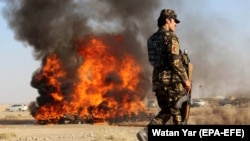Report: Afghan opium production up 87 percent in 2017
| Publisher | Radio Free Europe/Radio Liberty |
| Publication Date | 15 November 2017 |
| Cite as | Radio Free Europe/Radio Liberty, Report: Afghan opium production up 87 percent in 2017, 15 November 2017, available at: https://www.refworld.org/docid/5a9fc6758.html [accessed 28 May 2023] |
| Disclaimer | This is not a UNHCR publication. UNHCR is not responsible for, nor does it necessarily endorse, its content. Any views expressed are solely those of the author or publisher and do not necessarily reflect those of UNHCR, the United Nations or its Member States. |
November 15, 2017 11:19 GMT
RFE/RL
 An Afghan soldier stands guard as authorities burn drugs seized during counternarcotics operations in the southern province of Helmand.
An Afghan soldier stands guard as authorities burn drugs seized during counternarcotics operations in the southern province of Helmand.
A new report says opium production in Afghanistan increased by 87 percent to a "record level" of 9,000 tons this year, compared with 2016 levels.
That's according to the latest Afghanistan Opium Survey figures released on November 15 by the Afghan Ministry of Counternarcotics and the UN Office on Drugs and Crime (UNODC).
Afghanistan is the world's top producer of the poppy from which opium and heroin are produced.
"It is high time for the international community and Afghanistan to reprioritize drug control, and to acknowledge that every nation has a shared responsibility for this global problem," UNODC Executive Director Yury Fedotov said in a statement.
The survey said that 750 hectares used for poppy cultivation were eradicated this year, more than twice as much as in 2016.
However, areas under cultivation hit a record at 328,000 hectares, up 63 percent compared with 201,000 hectares last year.
The report also said that the number of poppy-producing provinces in the country increased from 21 to 24, with Ghazni, Samangan, and Nuristan provinces now also becoming poppy-growing regions.
It said a 15 percent increase in opium yield per hectare also contributed to the rise in production.
The total farm-gate value of the opium produced – the price of the opium at which it is sold by the farm – was up by more than 50 percent at around $1.4 billion, equivalent to about 7 percent of Afghanistan's estimated gross domestic product, the report said.
The latest figures were released as the Western-backed government in Kabul is struggling to beat back insurgents in the wake of the exit of most NATO-led forces in 2014.
The 2017 record levels of opium production and poppy cultivation create "multiple challenges" for Afghanistan, its neighbors, and the other countries that are transit for or destination of Afghan opiates, according to the survey.
"The significant levels of opium-poppy cultivation and illicit trafficking of opiates will probably further fuel instability, insurgency and increase funding to terrorist groups in Afghanistan," it said. "More high-quality, low-cost heroin will reach consumer markets across the world, with increased consumption and related harms as a likely consequence."
Link to original story on RFE/RL website
